Zone-Shrinking Fresnel Zone Travel-Time Tomography for Sound Speed Reconstruction in Breast USCT
Abstract
1. Introduction
2. Methods
2.1. USCT System
2.2. Fresnel Zone
2.3. Fresnel Zone Travel-Time Tomography (FZTT) and Zone-Shrinking FZTT (ZSFZTT)
3. Experiments and Results
3.1. Quantitative Evaluation Metrics
3.2. Numerical Breast Phantom Experiment
3.3. In Vivo Breast Experiment
4. Conclusions
Author Contributions
Funding
Acknowledgments
Conflicts of Interest
References
- Wiskin, J.W.; Malik, B.; Natesan, R.; Pirshafiey, N.; Klock, J.; Lenox, M. 3D Full Inverse Scattering Ultrasound Tomography of the Human Knee. In Medical Imaging 2019: Ultrasonic Imaging and Tomography; SPIE: Bellingham, WA, USA, 2019; p. 109550K. [Google Scholar]
- Bosch, J.G.; Doyley, M.M.; Duric, N.; Littrup, P.; Schmidt, S.; Li, C.; Roy, O.; Bey-Knight, L.; Janer, R.; Kunz, D.; et al. Breast Imaging with the SoftVue Imaging System: First Results. In Medical Imaging 2013: Ultrasonic Imaging, Tomography; SPIE: Bellingham, WA, USA, 2013; p. 86750K-1. [Google Scholar]
- Ruiter, N.; Zapf, M.; Dapp, R.; Hopp, T.; Gemmeke, H. First in vivo results with 3D ultrasound computer tomography. In Proceedings of the 2013 IEEE International Ultrasonics Symposium, Prague, Czech Republic, 21–25 July 2013. [Google Scholar]
- Lenox, M.W.; James, W.; Lewis, M.A.; Stephen, D.; David, B.; Scott, H. Imaging Performance of Quantitative Transmission Ultrasound. Int. J. Biomed. Imaging 2015, 2015, 1–8. [Google Scholar] [CrossRef] [PubMed]
- Xu, Y.; Duric, N.; Li, C.; Lupinacci, J.; Glide-Hurst, C. A study of 3-way image fusion for characterizing acoustic properties of breast tissue. Proc. SPIE Int. Soc. Opt. Eng. 2008, 6920, 692014. [Google Scholar]
- Duric, N.; Littrup, P.; Li, C.; Rama, O.; Beyknight, L.; Schmidt, S.; Lupinacci, J. Detection and characterization of breast masses with ultrasound tomography: Clinical results. Proc. SPIE Int. Soc. Opt. Eng. 2009, 7265, 72651G. [Google Scholar]
- Qu, X.; Azuma, T.; Yogi, T.; Azuma, S.; Takeuchi, H.; Tamano, S.; Takagi, S. Synthetic aperture ultrasound imaging with a ring transducer array: Preliminary ex vivo results. J. Med Ultrason. 2016, 43, 461–471. [Google Scholar] [CrossRef]
- Li, C.; Sandhu, G.Y.; Boone, M.; Duric, N. Breast Imaging Using Waveform Attenuation Tomography; Society of Photo-optical Instrumentation Engineers (SPIE): Bellingham, WA, USA, 2017; p. 101390A-1. [Google Scholar]
- Li, W.; Sun, X.; Wang, Y.; Niu, G.; Chen, X.; Qian, Z.; Nie, L. In vivo quantitative photoacoustic microscopy of gold nanostar kinetics in mouse organs. Biomed. Opt. Express 2014, 5, 2679. [Google Scholar] [CrossRef]
- Huang, C.; Nie, L.; Schoonover, R.W.; Wang, L.V.; Anastasio, M.A. Photoacoustic computed tomography correcting for heterogeneity and attenuation. J. Biomed. Opt. 2012, 17, 061211. [Google Scholar] [CrossRef]
- Li, C.; Duric, N.; Huang, L. Clinical breast imaging using sound-speed reconstructions of ultrasound tomography data. Proc. SPIE Int. Soc. Opt. Eng. 2008, 6920, 692009. [Google Scholar]
- Suzuki, A.; Tsubota, Y.; Wu, W.; Yamanaka, K.; Terada, T.; Kawabata, K. Full Waveform Inversion for Ultrasound Computed Tomography with High-Sensitivity Scan Method. In Medical Imaging 2019: Ultrasonic Imaging and Tomography; SPIE: Bellingham, WA, USA, 2019; p. 109550A. [Google Scholar]
- Matthews, T.; Wang, K.; Li, C.; Duric, N.; Anastasio, M. Regularized Dual Averaging Image Reconstruction for Full-Wave Ultrasound Computed Tomography. IEEE Trans. Ultrason. Ferroelectr. Freq. Control 2017, 64, 811–825. [Google Scholar] [CrossRef]
- Feng, B.; Xu, W.; Luo, F.; Wang, H. Rytov-approximation-based wave-equation traveltime tomography. Geophysics 2020, 85, R289–R297. [Google Scholar] [CrossRef]
- Birk, M.; Dapp, R.; Ruiter, N.V.; Becker, J. GPU-based iterative transmission reconstruction in 3D ultrasound computer tomography. J. Parallel Distrib. Comput. 2014, 74, 1730–1743. [Google Scholar] [CrossRef]
- Wu, W.; Tsubota, Y.; Suzuki, A.; Yamanaka, K.; Terada, T.; Kawabata, K.; Yamashita, H.; Kato, F.; Nishida, M.; Satoh, M. High SNR Emission Method with Virtual Point Source in Ultrasound Computed Tomography. In Medical Imaging 2019: Ultrasonic Imaging and Tomography; SPIE: Bellingham, WA, USA, 2019; p. 109550I. [Google Scholar]
- Perez-Liva, M.; Udías, J.M.; Camacho, J.; Merčep, E.; Deán-Ben, X.L.; Razansky, D.; Herraiz, J.L. Speed of sound ultrasound transmission tomography image reconstruction based on Bézier curves. Ultrasonics 2020, 103, 106097. [Google Scholar] [CrossRef] [PubMed]
- Liu, Y.; Dong, L.; Wang, Y.; Zhu, J.; Ma, Z. Sensitivity kernels for seismic Fresnel volume tomography. Geophysics 2009, 74, U35–U46. [Google Scholar] [CrossRef]
- Woodward, M.J. Wave-equation tomography. Geophysics 1992, 57, 15–26. [Google Scholar] [CrossRef]
- Watanabe, T.; Matsuoka, T.; Ashida, Y. Seismic Traveltime Tomography Using Fresnel Volume Approach. In SEG Technical Program Expanded Abstracts 1999; Society of Exploration Geophysicists: Houston, TX, USA, 1999; pp. 1402–1405. [Google Scholar]
- Dahlen, F.A.; Hung, S.H.; Nolet, G. Frechet kernels for finite-frequency traveltimes-I. Theory. Geophys. J. Int. 2000, 141, 157–174. [Google Scholar] [CrossRef]
- Roy, O.; Schmidt, S.; Li, C.; Allada, V.; Duric, N. Breast imaging using ultrasound tomography: From clinical requirements to system design. In Proceedings of the 2013 IEEE International Ultrasonics Symposium (IUS), Prague, Czech Republic, 21–25 July 2013. [Google Scholar]
- Lou, C.; Xu, M.; Ding, M.; Yuchi, M. Spatial Smoothing Coherence Factor for Ultrasound Computed Tomography. In Medical Imaging 2016: Ultrasonic Imaging and Tomography; SPIE: Bellingham, WA, USA, 2016; p. 979008. [Google Scholar]
- Wang, S.; Xu, M.; Zhou, L.; Ding, M.; Yuchi, M. Synthetic Aperture Focusing Technique for 3-D Ultrasound Computed Tomography. J. Med. Imaging Health Inform. 2018, 8, 45–49. [Google Scholar] [CrossRef]
- Wang, S.; Li, C.; Ding, M.; Yuchi, M. Frequency-Shift Low-Pass Filtering and Least Mean Square Adaptive Filtering for Ultrasound Imaging. In Medical Imaging 2016: Ultrasonic Imaging and Tomography; SPIE: Bellingham, WA, USA, 2016; p. 97900P. [Google Scholar]
- Fang, X.; Song, J.; Liu, K.; Wu, Y.; Zhang, Q.; Ding, M.; Yuchi, M. A Prior-Information-Based Combination Solution for Picking the Difference of Time-of-Flight in Ultrasound Computed Tomography. J. Med. Imaging Health Inform. 2020, 10, 763–768. [Google Scholar] [CrossRef]
- Vidale, J. Finite-difference calculation of travel times. Geophysics 1988, 55, 521–526. [Google Scholar] [CrossRef]
- Li, C.; Huang, L.; Duric, N.; Zhang, H.; Rowe, C. An improved automatic time-of-flight picker for medical ultrasound tomography. Ultrasonics 2009, 49, 61–72. [Google Scholar] [CrossRef]
- Marquering, H.; Dahlen, F.A.; Nolet, G. Three-dimensional sensitivity kernels for finite-frequency traveltimes: The banana-doughnut paradox. Geophys. J. R. Astron. Soc. 2010, 137, 805–815. [Google Scholar] [CrossRef]
- Jocker, J.; Spetzler, J.; Smeulders, D.; Trampert, J. Validation of first-order diffraction theory for the traveltimes and amplitudes of propagating waves. Geophysics 2006, 71, T167–T177. [Google Scholar] [CrossRef][Green Version]
- Nocedal, J.; Wright, S.J. Limited-Memory Quasi-Newton Methods: Numerical Optimization, 2nd ed.; Mikosch, T.V., Resnich, S.I., Robinson, S.M., Eds.; Springer: New York, NY, USA, 2000. [Google Scholar]
- Treeby, B.E.; Jaros, J.; Rendell, A.P.; Cox, B.T. Modeling nonlinear ultrasound propagation in heterogeneous media with power law absorption using a k-space pseudospectral method. J. Acoust Soc. Am. 2012, 131, 4324–4336. [Google Scholar] [CrossRef] [PubMed]
- Malik, B.; Terry, R.; Wiskin, J.; Lenox, M. Quantitative transmission ultrasound tomography: Imaging and performance characteristics. Med. Phys. 2018, 45, 3063–3075. [Google Scholar] [CrossRef] [PubMed]

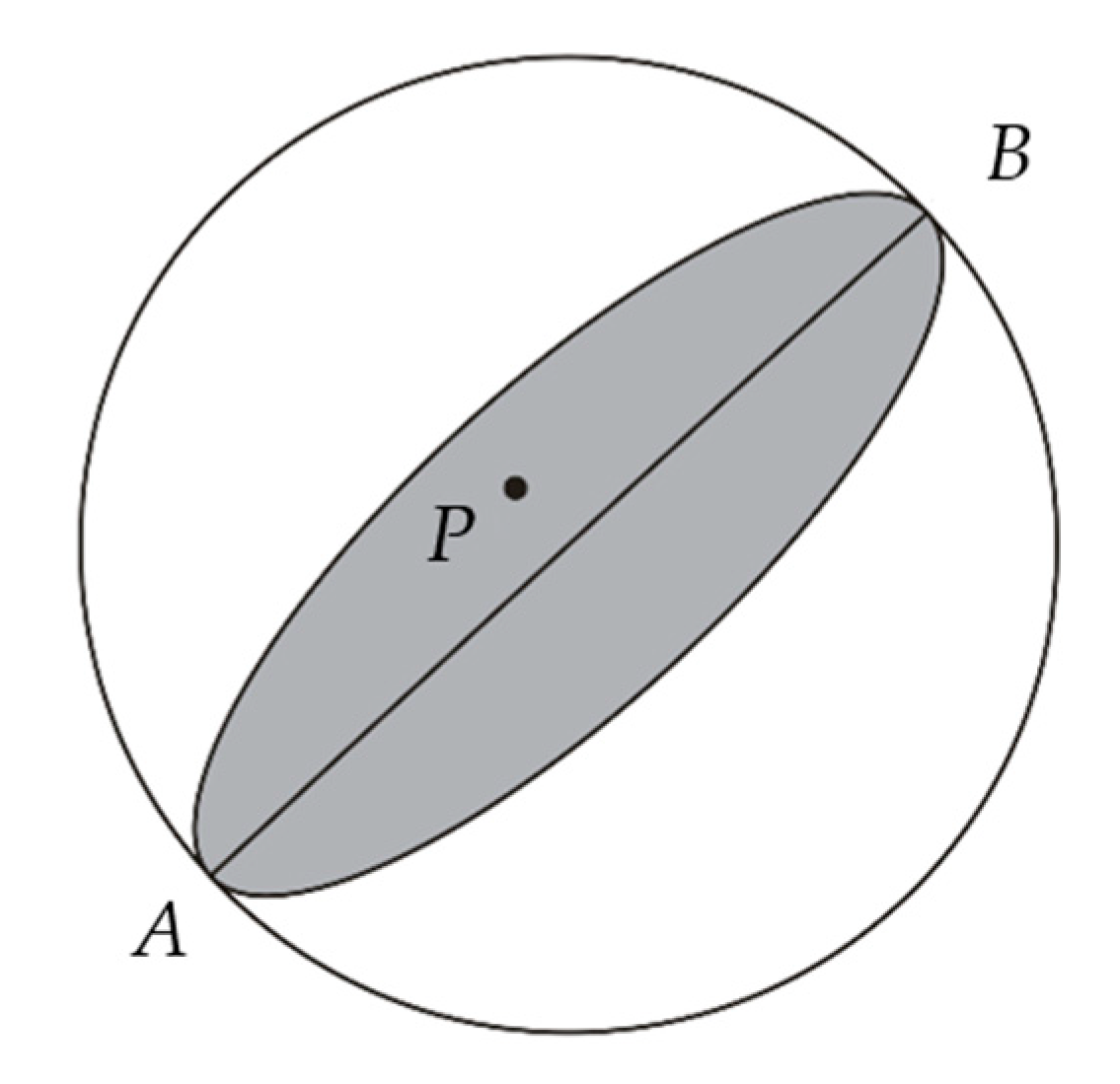

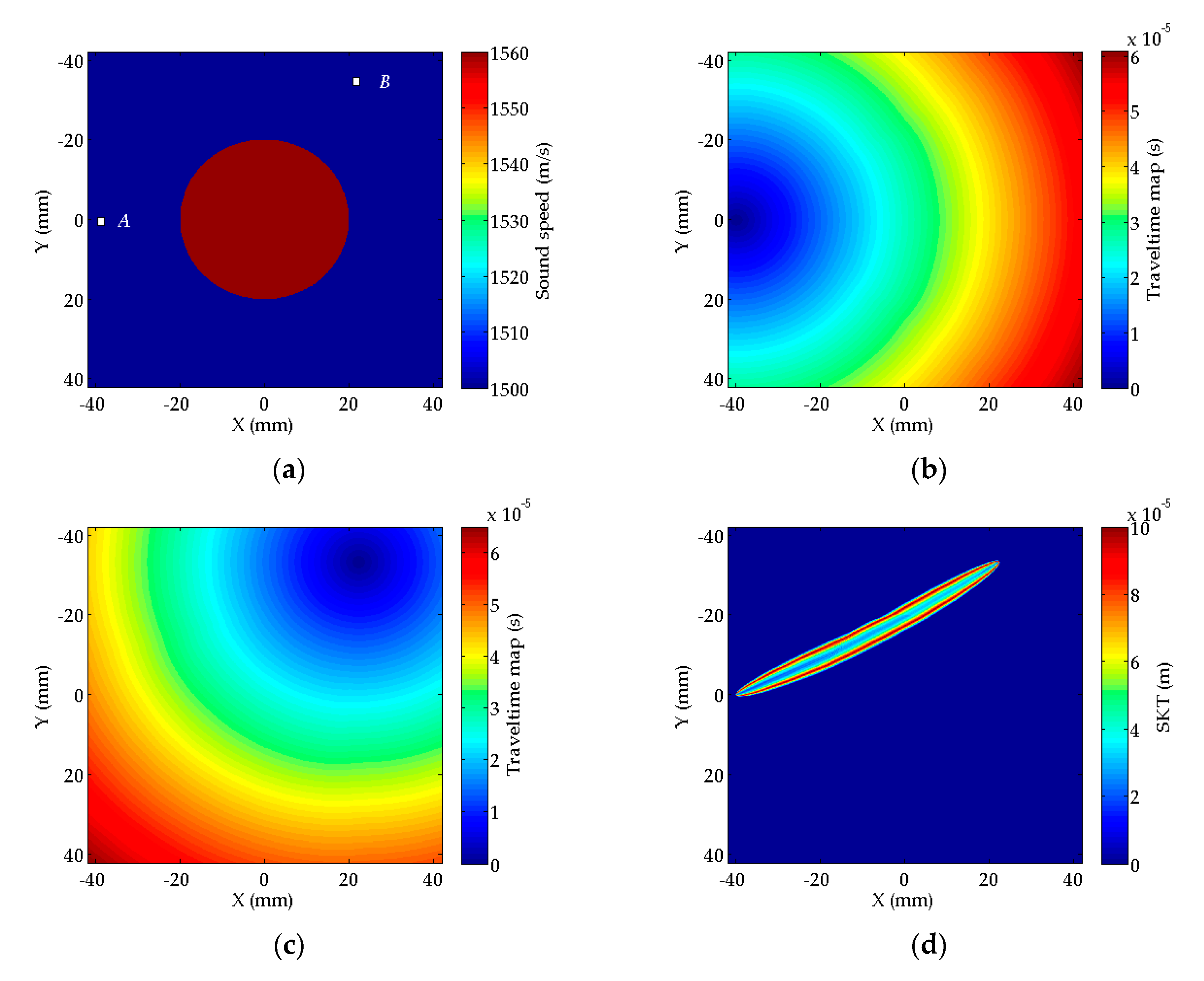
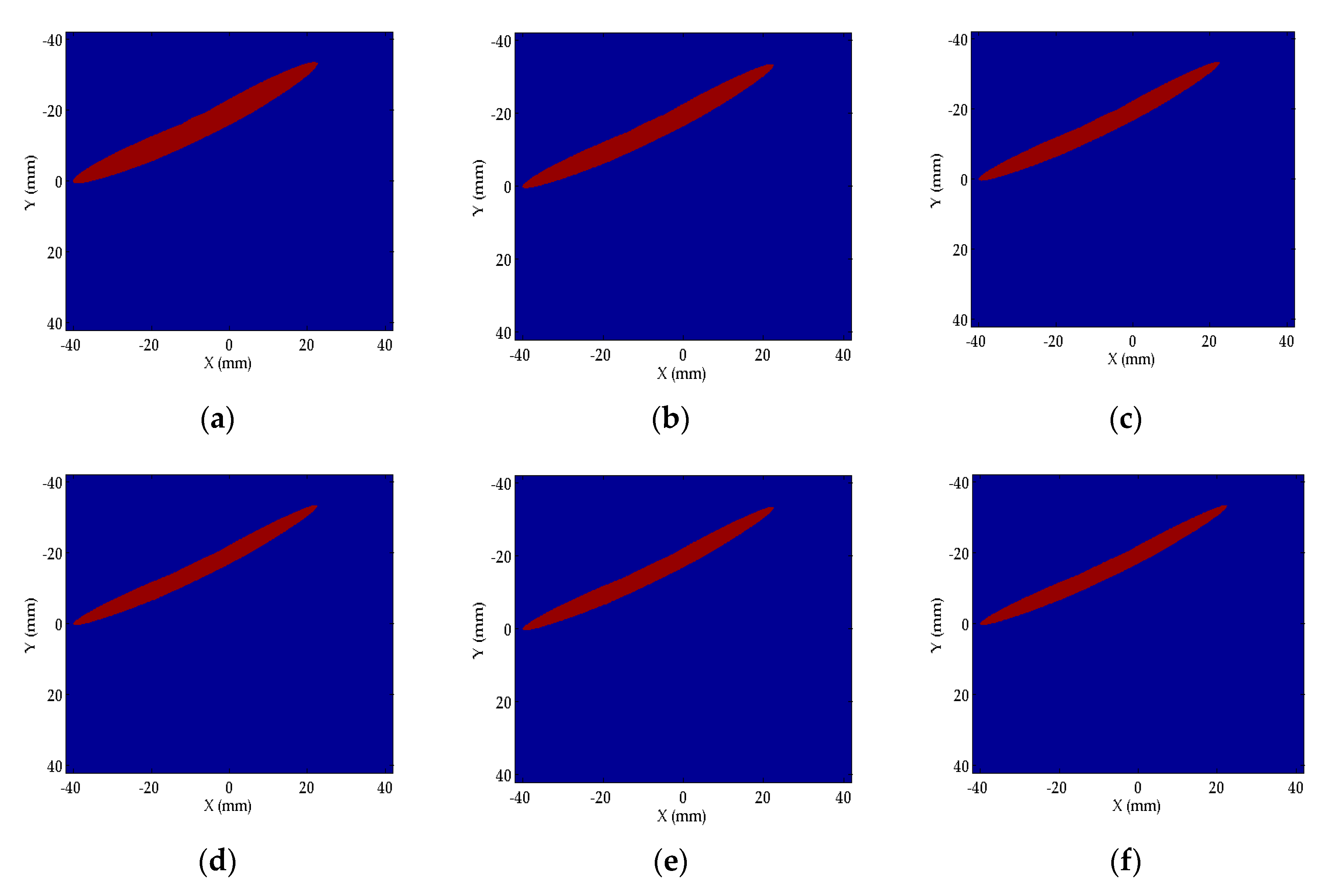

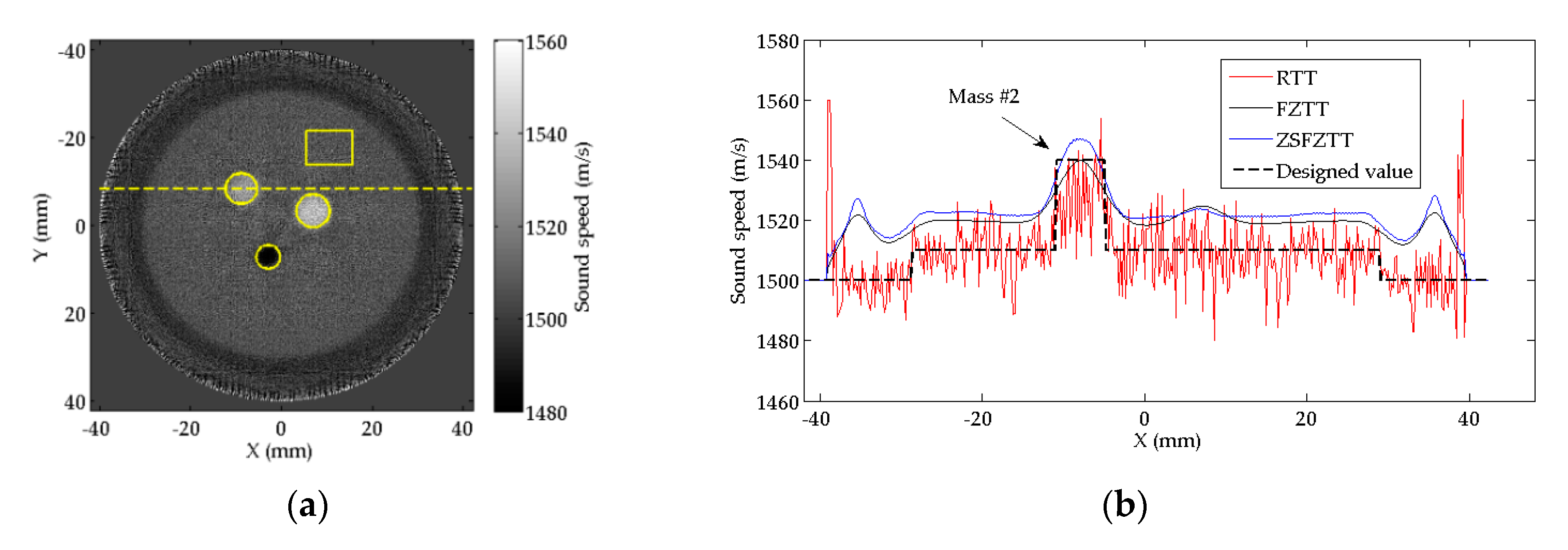

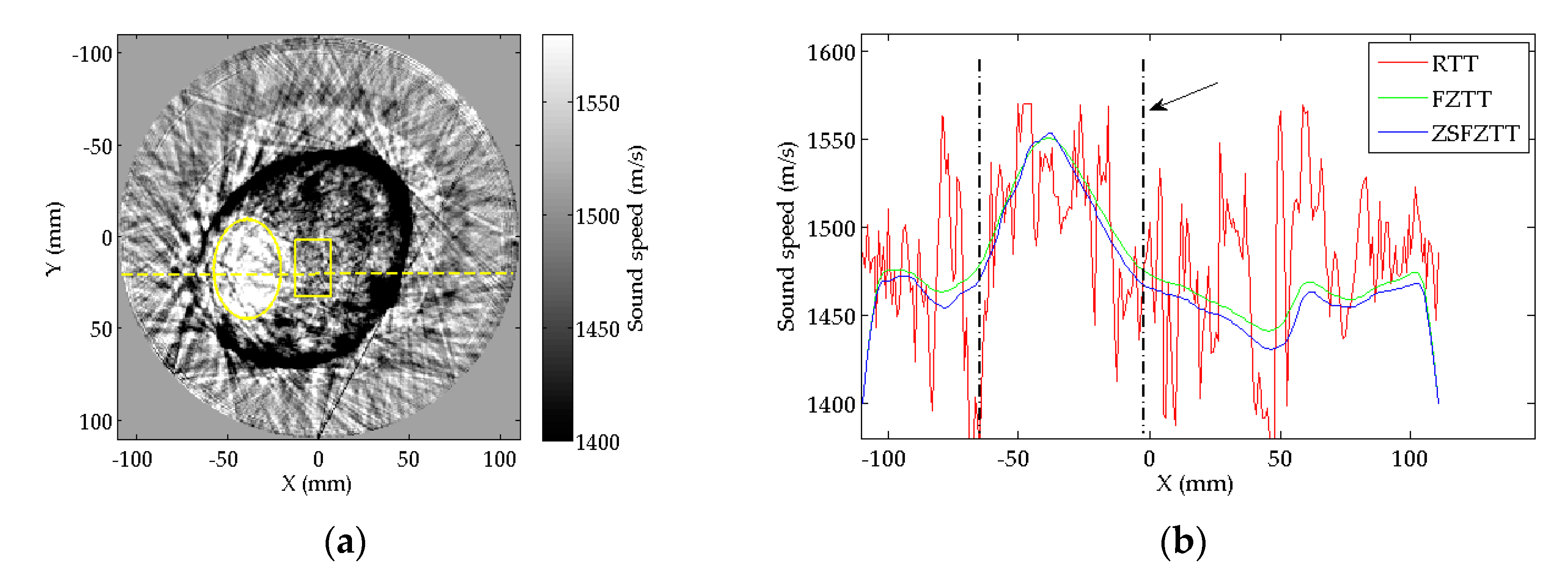
| Background | Mass #1 | Mass #2 | Mass #3 | |
|---|---|---|---|---|
| (m/s) | 1510 | 1560 | 1540 | 1480 |
| (mm) | 60 | 6 | 6 | 6 |
| Methods | Diameter (mm) | ||||
|---|---|---|---|---|---|
| Background | Mass #1 | Mass #2 | Mass #3 | ||
| 60 | 6 | 6 | 6 | ||
| RTT | 61.1 | 7.5 | 6.8 | 4.8 | |
| 1.8% | 25% | 13.3% | 20% | ||
| FZTT | 61.4 | 7.9 | 7.6 | 6.6 | |
| 2.3% | 31.7% | 26.7% | 10% | ||
| ZSFZTT | 60.1 | 6.2 | 6.1 | 5.5 | |
| 0.2% | 3.3% | 1.7% | 8.3% | ||
| Methods | Sound Speed (m/s) | ||||
|---|---|---|---|---|---|
| Background | Mass #1 | Mass #2 | Mass #3 | ||
| 1510 | 1560 | 1540 | 1480 | ||
| RTT | 1507.0 | 1533.1 | 1523.7 | 1486.1 | |
| 0.2% | 1.7% | 1.1% | 0.4% | ||
| FZTT | 1520.5 | 1540.1 | 1534.2 | 1506.4 | |
| 0.7% | 1.3% | 0.4% | 5.4% | ||
| ZSFZTT | 1522.8 | 1551.8 | 1543.1 | 1500.2 | |
| 0.8% | 0.5% | 0.2% | 1.4% | ||
| Methods | Background | Mass #1 | Mass #2 | Mass #3 | |
|---|---|---|---|---|---|
| RTT | (m/s) | 1507.0 | 1533.1 | 1523.7 | 1486.1 |
| -- | 47.8% | 44.3% | 30.3% | ||
| FZTT | (m/s) | 1520.5 | 1540.1 | 1534.2 | 1506.4 |
| -- | 60.8% | 54.3% | 53% | ||
| ZSFZTT | (m/s) | 1522.8 | 1551.8 | 1543.1 | 1500.2 |
| -- | 42% | 33.3% | 24.7% |
| Methods | Background | Mass #1 | Mass #2 | Mass #3 | |
|---|---|---|---|---|---|
| RTT | (m/s) | 1507.0 ± 9.6 | 1533.1 ± 11.7 | 1523.7 ± 12.0 | 1486.1 ± 6.5 |
| -- | 2.7 | 1.7 | 2.2 | ||
| FZTT | (m/s) | 1520.5 ± 0.2 | 1540.1 ± 6.7 | 1534.2 ± 2.9 | 1506.4 ± 2.9 |
| -- | 98 | 68.5 | 70.5 | ||
| ZSFZTT | (m/s) | 1522.8 ± 0.3 | 1551.8 ± 7.9 | 1543.1 ± 5.0 | 1500.2 ± 5.2 |
| -- | 96.6 | 67.7 | 75.3 |
| Methods | Normal Tissue | Tumor | |
|---|---|---|---|
| RTT | (m/s) | 1463.9 ± 37.3 | 1534.7 ± 39.6 |
| -- | 1.9 | ||
| FZTT | (m/s) | 1468.8 ± 6.6 | 1522.4 ± 11.7 |
| -- | 8.1 | ||
| ZSFZTT | (m/s) | 1467.2 ± 7.2 | 1529.4 ± 12.1 |
| -- | 8.6 |
© 2020 by the authors. Licensee MDPI, Basel, Switzerland. This article is an open access article distributed under the terms and conditions of the Creative Commons Attribution (CC BY) license (http://creativecommons.org/licenses/by/4.0/).
Share and Cite
Fang, X.; Wu, Y.; Song, J.; Yin, H.; Zhou, L.; Zhang, Q.; Quan, Z.; Ding, M.; Yuchi, M. Zone-Shrinking Fresnel Zone Travel-Time Tomography for Sound Speed Reconstruction in Breast USCT. Sensors 2020, 20, 5563. https://doi.org/10.3390/s20195563
Fang X, Wu Y, Song J, Yin H, Zhou L, Zhang Q, Quan Z, Ding M, Yuchi M. Zone-Shrinking Fresnel Zone Travel-Time Tomography for Sound Speed Reconstruction in Breast USCT. Sensors. 2020; 20(19):5563. https://doi.org/10.3390/s20195563
Chicago/Turabian StyleFang, Xiaoyue, Yun Wu, Junjie Song, Hang Yin, Liang Zhou, Qiude Zhang, Zhaohui Quan, Mingyue Ding, and Ming Yuchi. 2020. "Zone-Shrinking Fresnel Zone Travel-Time Tomography for Sound Speed Reconstruction in Breast USCT" Sensors 20, no. 19: 5563. https://doi.org/10.3390/s20195563
APA StyleFang, X., Wu, Y., Song, J., Yin, H., Zhou, L., Zhang, Q., Quan, Z., Ding, M., & Yuchi, M. (2020). Zone-Shrinking Fresnel Zone Travel-Time Tomography for Sound Speed Reconstruction in Breast USCT. Sensors, 20(19), 5563. https://doi.org/10.3390/s20195563





